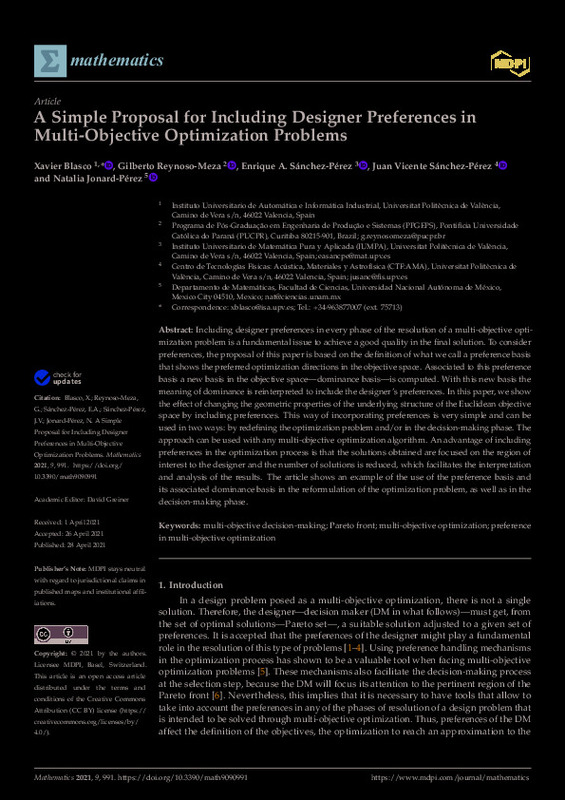JavaScript is disabled for your browser. Some features of this site may not work without it.
Buscar en RiuNet
Listar
Mi cuenta
Estadísticas
Ayuda RiuNet
Admin. UPV
A Simple Proposal for Including Designer Preferences in Multi-Objective Optimization Problems
Mostrar el registro sencillo del ítem
Ficheros en el ítem
| dc.contributor.author | Blasco, Xavier
|
es_ES |
| dc.contributor.author | Reynoso Meza, Gilberto
|
es_ES |
| dc.contributor.author | Sánchez Pérez, Enrique Alfonso
|
es_ES |
| dc.contributor.author | Sánchez Pérez, Juan Vicente
|
es_ES |
| dc.contributor.author | Jonard Pérez, Natalia
|
es_ES |
| dc.date.accessioned | 2022-11-28T19:01:37Z | |
| dc.date.available | 2022-11-28T19:01:37Z | |
| dc.date.issued | 2021-05-28 | es_ES |
| dc.identifier.uri | http://hdl.handle.net/10251/190267 | |
| dc.description.abstract | [EN] Including designer preferences in every phase of the resolution of a multi-objective optimization problem is a fundamental issue to achieve a good quality in the final solution. To consider preferences, the proposal of this paper is based on the definition of what we call a preference basis that shows the preferred optimization directions in the objective space. Associated to this preference basis a new basis in the objective space-dominance basis-is computed. With this new basis the meaning of dominance is reinterpreted to include the designer's preferences. In this paper, we show the effect of changing the geometric properties of the underlying structure of the Euclidean objective space by including preferences. This way of incorporating preferences is very simple and can be used in two ways: by redefining the optimization problem and/or in the decision-making phase. The approach can be used with any multi-objective optimization algorithm. An advantage of including preferences in the optimization process is that the solutions obtained are focused on the region of interest to the designer and the number of solutions is reduced, which facilitates the interpretation and analysis of the results. The article shows an example of the use of the preference basis and its associated dominance basis in the reformulation of the optimization problem, as well as in the decision-making phase. | es_ES |
| dc.description.sponsorship | This work has been supported by the Ministerio de Ciencia, Innovacion y Universidades, Spain, under Grant RTI2018-096904-B-I00. | es_ES |
| dc.language | Inglés | es_ES |
| dc.publisher | MDPI AG | es_ES |
| dc.relation.ispartof | Mathematics | es_ES |
| dc.rights | Reserva de todos los derechos | es_ES |
| dc.subject | Multi-objective decision-making | es_ES |
| dc.subject | Pareto front | es_ES |
| dc.subject | Multi-objective optimization | es_ES |
| dc.subject | Preference in multi-objective optimization | es_ES |
| dc.subject.classification | FISICA APLICADA | es_ES |
| dc.subject.classification | INGENIERIA DE SISTEMAS Y AUTOMATICA | es_ES |
| dc.subject.classification | MATEMATICA APLICADA | es_ES |
| dc.title | A Simple Proposal for Including Designer Preferences in Multi-Objective Optimization Problems | es_ES |
| dc.type | Artículo | es_ES |
| dc.identifier.doi | 10.3390/math9090991 | es_ES |
| dc.relation.projectID | info:eu-repo/grantAgreement/AEI/Plan Estatal de Investigación Científica y Técnica y de Innovación 2017-2020/RTI2018-096904-B-I00/ES/HERRAMIENTAS DE OPTIMIZACION MULTIOBJETIVO PARA LA CARACTERIZACION Y ANALISIS DE CONCEPTOS DE DISEÑO Y SOLUCIONES SUB-OPTIMAS EFICIENTES EN PROBLEMAS DE INGENIERIA DE SISTEMAS/ | es_ES |
| dc.rights.accessRights | Abierto | es_ES |
| dc.contributor.affiliation | Universitat Politècnica de València. Escuela Técnica Superior de Ingeniería Geodésica, Cartográfica y Topográfica - Escola Tècnica Superior d'Enginyeria Geodèsica, Cartogràfica i Topogràfica | es_ES |
| dc.contributor.affiliation | Universitat Politècnica de València. Escuela Técnica Superior de Ingenieros de Caminos, Canales y Puertos - Escola Tècnica Superior d'Enginyers de Camins, Canals i Ports | es_ES |
| dc.contributor.affiliation | Universitat Politècnica de València. Escuela Técnica Superior de Ingenieros Industriales - Escola Tècnica Superior d'Enginyers Industrials | es_ES |
| dc.description.bibliographicCitation | Blasco, X.; Reynoso Meza, G.; Sánchez Pérez, EA.; Sánchez Pérez, JV.; Jonard Pérez, N. (2021). A Simple Proposal for Including Designer Preferences in Multi-Objective Optimization Problems. Mathematics. 9(9):1-19. https://doi.org/10.3390/math9090991 | es_ES |
| dc.description.accrualMethod | S | es_ES |
| dc.relation.publisherversion | https://doi.org/10.3390/math9090991 | es_ES |
| dc.description.upvformatpinicio | 1 | es_ES |
| dc.description.upvformatpfin | 19 | es_ES |
| dc.type.version | info:eu-repo/semantics/publishedVersion | es_ES |
| dc.description.volume | 9 | es_ES |
| dc.description.issue | 9 | es_ES |
| dc.identifier.eissn | 2227-7390 | es_ES |
| dc.relation.pasarela | S\437275 | es_ES |
| dc.contributor.funder | AGENCIA ESTATAL DE INVESTIGACION | es_ES |








